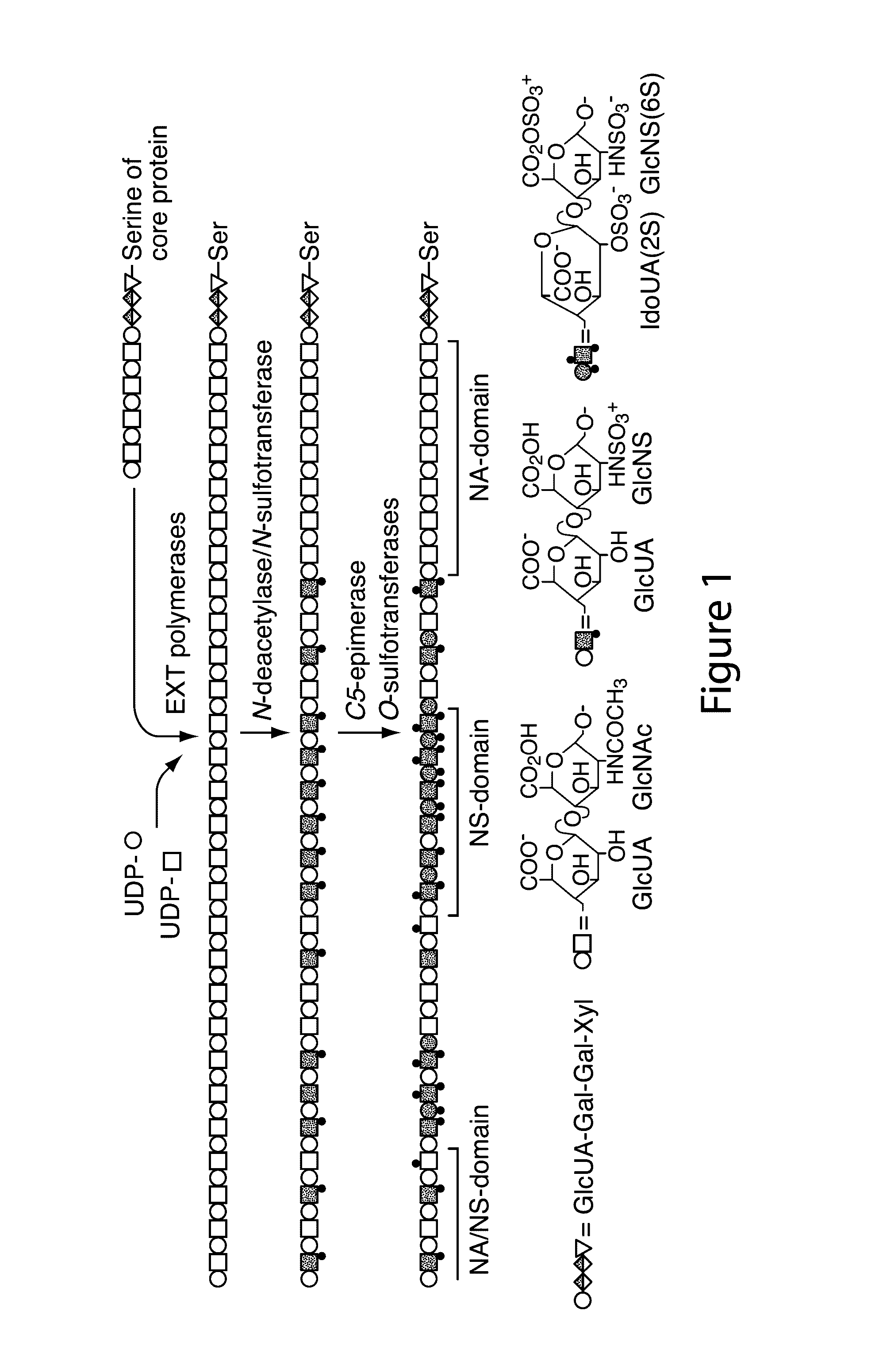Transgenic production of heparin
a technology of heparin and heparin derivative, which is applied in the direction of animal/human proteins, drug compositions, extracellular fluid disorders, etc., can solve the problem of contamination of heparin
- Summary
- Abstract
- Description
- Claims
- Application Information
AI Technical Summary
Benefits of technology
Problems solved by technology
Method used
Image
Examples
examples
1. Safety Studies
[0058]1.1 Testing the Effect of Heparin on the Mammary Gland
[0059]The effect of heparin on the lactating mammary gland was assessed. The level of goat antithrombin (AT) in the mammary gland is about 2 μg / ml, which is 1% of that found in the blood stream. Heparin can be infused into the mammary gland of lactating goats at levels that correspond to the production levels of 1 mg / ml, 200 μg / ml and 50 μg / ml. Since the goat mammary gland can hold 1 liter of milk, the heparin can be infused following milking and the milk removed the following day (infusion of 1 g, 200 mg and 50 mg of high molecular weight heparin). The infusion can be carried out daily for one week or until toxicity is observed in the mammary gland or in the blood.
[0060]Levels of heparin can be measured in the milk and in the bloodstream of the animals being tested. Earlier studies have shown that some proteins produced in the mammary gland could leak into the circulation to a level 1% of that found in the...
experiment 1
[0074]Systemic administration of heparin is demonstrated herein to have little, if any, effect on body temperature or milk production volume. Low and medium levels of systemic heparin appear to gradually increase aPTTs to 40-50 seconds (normal ranges 20-40). High levels of systemic heparin have a large effect on aPTTs after injection, often rising to coagulation times beyond what could be measured by the machine (>124 sec). But, the aPTTs dropped over night (between the two high doses) to the low 40's, similar to what was seen with the low and medium levels of systemic heparin. There were no obvious gross signs of bleeding, such as petechiae in the oral mucosa, the vulva or udder. In one of the goats during high levels of heparin administration, increased, “crackling” lung sounds could be heard. However, there was no evidence of any blood-tinged exudate from the nose during this time.
[0075]From these results, it can be concluded that, surprisingly, systemic heparin administered over...
experiment 2
[0076]Single daily infusions of low or medium dose heparin into the udder for a week were found to have little effect on body temperature, did not produce any signs of bleeding, and did not increase aPTTs beyond 55 seconds. High levels of infused heparin dramatically increased aPTTs, and infusion of the highest levels appeared to have systemic affects including high body temperature and increased respiratory sounds. The udder of the goat infused with the highest levels appeared to have an inflammatory response, and a dramatic decrease in milk production. However, in this experiment, the goats were milked out and pure heparin was infused, undiluted, directly into the udder. In a transgenic goat producing heparin, the protein is produced with the milk, and is therefore diluted. In addition, heparin produced by the goat itself may not be identical to the exogenous heparin that was infused.
[0077]From these studies, it can be concluded that low and medium doses of systemic and infused he...
PUM
| Property | Measurement | Unit |
|---|---|---|
| weight | aaaaa | aaaaa |
| composition | aaaaa | aaaaa |
| heterogeneity | aaaaa | aaaaa |
Abstract
Description
Claims
Application Information
 Login to View More
Login to View More - R&D
- Intellectual Property
- Life Sciences
- Materials
- Tech Scout
- Unparalleled Data Quality
- Higher Quality Content
- 60% Fewer Hallucinations
Browse by: Latest US Patents, China's latest patents, Technical Efficacy Thesaurus, Application Domain, Technology Topic, Popular Technical Reports.
© 2025 PatSnap. All rights reserved.Legal|Privacy policy|Modern Slavery Act Transparency Statement|Sitemap|About US| Contact US: help@patsnap.com

